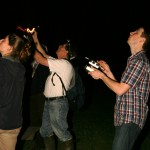What the Ears Don’t Hear…
CWF visits the “Big Muddy” to learn acoustic bat detection technology
By MacKenzie Hall, Private Lands Biologist

For the past week, fellow CWF’er Brian Henderson and I have been getting familiar with our new toys – two AnaBat acoustic detectors. We bought the detectors with help from a NJ Landowner Incentive Program (LIP) grant to monitor and learn more about New Jersey’s bats. The four-day training took place at Western Illinois University’s Kibbe Field Station in Warsaw, Illinois, just a couple thousand feet from the mighty Mississippi River. We were lucky to have three long-time bat researchers as instructors: Kim Livengood, Cori Lausen, and AnaBat pioneer Chris Corben.

Acoustic detectors are able to “hear” and record the the echolocation calls that bats give off as they travel and hunt for insects. Different bat species produce unique call patterns at varying frequencies of sound that can be used to tell them apart (although many calls are very similar and sometimes impossible to distinguish). Acoustic technology thus allows you to document the diversity and abundance of bats in an area of interest.
The detectors can be used while walking or driving, or they can be set up outside and left to record data for several days, weeks, or even months. We’ll be doing all of these things, some of them as part of regional/national studies.

At AnaBat training, classroom tutorials were followed each day by nighttime acoustic surveys. The first night that we went out with our straight-outta-the-box detectors, I can only describe our reaction as bubbly…our “Ooh!”/“Whoa!”/“No way!” squeals were utterly countless as the telltale tick-marks popped up on our PDA screen, indicating nearby bats that we could neither see nor hear on our own.
Back in the classroom, we downloaded the previous night’s bat calls onto our laptops and practiced identifying the types of bats who had made them –red bats, big brown bats, evening bats, hoary bats, tricolored bats,…and even an endangered Indiana bat or two. All without having to catch, hold, or even see a thing.
We’re excited to start using this technology in our bat research here in NJ. Check back for updates about our work with AnaBat!